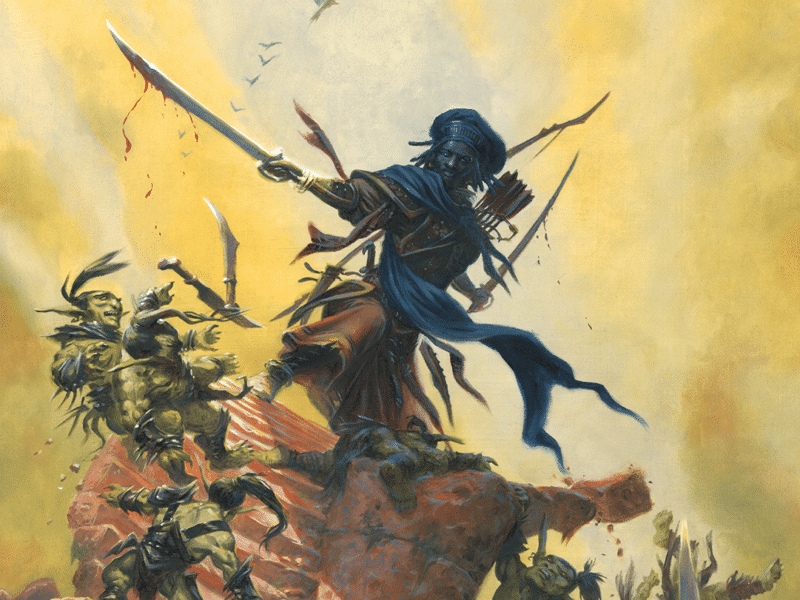The section on spells in the Player’s Handbook contains a plethora of spells that D&D characters can cast, ranging from weak enchantments that might help the caster win a game of dice to immensely powerful incantations that can wreck villages, summon demonic allies in battles, and vanquish your enemies with the wave of your hand (or, as in the case of the spell disintegrate, make your opponent vanish for good!).
Numbering in the hundreds, this collection of spells features plenty of variation and imagination, and spellcasters of all types can find thematically appropriate spells as well as optimal ones that turn you into a deadly combatant in fights. No matter if you’re a wizard who’s specialised in telling the future, a sorcerer who taps into their draconic ancestry to hurl balls of destructive fire, or a druid with a close affinity to nature and its innate magic forces, the standard catalogue in Dungeons & Dragons covers almost every thinkable type of fantasy hero.
But as Dungeons & Dragons is a game of the fantastic that has lots of space for originality and invention, a creative Dungeon Master can – and often wants to – cobble together brand new spells to surprise and delight (or terrify) their players. And players can obviously do the same, of course, if their Dungeon Master permits it. The reasons for doing this are manifold: perhaps one has come up with a concept for a character that calls for a unique kind of curse, or maybe the setting itself prompts the DM to invent a new form of hex that emphasises the specific nature of the imagined world. New spells also make for excellent treasure and rewards, as they offer a breath of fresh air to long-time players who have read and cast most of the classic spells. An interesting homebrewed spell can make the most exhausted and sugar-overloaded player sit up straight in their seat and pay attention, because novelty and unpredictability are two of the best ways to maintain interest in an adventure and keep spirits high around a gaming table.
Better still, as the internet has become a central part of Dungeons & Dragons, stressed and busy DMs don’t have to dream up their own new spells! As soon as online forums became common, players and DMs around the world started to post their own homemade spells. These days, a quick search can yield thousands of custom incantations – but as such a wealth of options can be a little overwhelming, I’ve scoured the farthest corners of the web and returned to this article with a few spells that are especially intriguing, quirky, or effective – or combinations of all three! So get your quills and spellbooks out, and let’s dive into the list.

This spell does pretty much exactly what its title suggests, and anyone who has played the video game Diablo will immediately suspect what it is all about. Yes, we’re talking about an incantation that lets the caster target a recently deceased creature and cause its body to detonate, causing damage to other creatures that are near it. On a screen, it’s a gory but effective way to dish out damage when rushing through a dungeon – but when converted to a spell for D&D, the effect becomes truly chilling and unsettling. The spell is likely to particularly effective against large numbers of foes with few hit points, such as goblins. One neat feature is that its area of effect increases for each slain creature larger than medium-sized. Of course, its material component is – you guessed it! – a corpse. As you would expect, the spell belongs firmly in the school of Necromancy, but I’m less sure about the necrotic damage – piercing and psychic damage could work just as well.
No, that question mark is not a mistake: this spell is actually called bees? Most suited for druids, and possibly rangers too, this cantrip sends a spray of (presumably enraged) bees in the face of your opponent and deals them a solid d12 of poison damage. At higher levels, you can create additional swarms to deal more damage. In this sense, it’s kind of a reskinned eldritch blast, with a slightly higher damage output motivated by the fact that many monsters are resistant or immune to poison damage, especially on higher levels. So what makes this spell worthy of inclusion on this list, I hear you ask? Primarily, it’s the spectacle when one imagines this spell in effect: a big, loudly humming swarm of furious bees that dart towards another creature is hilarious and scary at the same time. It’s sort of the extreme opposite of a discrete attack spell, and it is likely to cause tumult in a crowded environment. Besides, imagine all the pranks that your characters can pull with this spell! Is there a keyhole in the door to the inn’s room in which that annoying merchant is snoring away? Send in a swarm and see what happens!
On to a spell that lets your character go full-on CSI! Perfect for a mystery adventure that requires lots of investigation and honed deductive skills, this spell enables you to analyse a small sample of blood and learn lots of secrets from its contents. You can tell straight away if you’ve analysed blood from the same creature at some point before (making it tempting to cast the spell frequently to build up a library of bloody samples, so to speak), and you can also tell at which point in time that you did so. But this spell gets really interesting when it’s cast on higher levels! For example, using higher spell slots allow you to tell which type of creature the blood comes from, if it’s been tainted by poisons or diseases, if the creature is still alive, and so on. If you’re able and willing to burn a ninth-level slot, you can even gain the recent memories of the creature!
Lavorre’s Zone of Truth or Dare
Another spell that’s almost tailor-made for adventures that rely on wit and intrigue, this enchantment is a variation of good old zone of truth – but with a highly entertaining twist: as the name suggests, rather than forcing a targeted creature to be honest, the spell compels it to engage in a game of Truth or Dare (as long as the dare part won’t mean any great danger to it)! Midnight Tower’s adventure An Unexpected Wedding Invitation is a perfect example of a mystery in which this spell would fit marvellously well. However, as will all mysteries, it’s prudent to be careful with adding or allowing any spell such as this, as it might let the characters cut straight to the heart of a secret!
More mystery-adventure-themed spells! This one lets a caster target a deceased creature to relive their last seconds before they perished. Possibly a rather harrowing experience, I would argue – but also phenomenally effective for exposition and moving a story along. For obvious reasons, DMs are advised to be careful with this spell if their adventure is built around the hidden identity of a murderer. That being said, the spell can give rise to an engaging and powerful visual moment if it’s woven into the story!
This is the kind of spell that is likely to incense NPCs and monsters with spellcasting abilities! It’s also a much more entertaining way to shut down a hostile spellcaster than just casting counterspell. As you will have guessed from its name, spellsteal enables the caster to snatch a spell from an enemy and use it against them instead. There are a few limitations: you must cast the stolen spell on your next turn, which means you’re committed to a specific action when it’s your turn unless you want to drop the spell in favour of doing something else. You don’t need to be able to cast the spell originally, and the victim who’s robbed of their spell still loses the slot that they used. Depending on the DM, you may or may not know exactly what kind of spell it is that you’ll steal before deciding to cast this spell – I would argue that not knowing makes for a much more interesting scenario!
This spell is probably the most technical and tactically useful one on this list. Designed as a cantrip (which seems rather generous – you might want to consider making this a first-level spell instead!), test strike deals a small amount of damage to a designated target. However, this isn’t the point of the spell! Upon impact, the spell generates a small shower of motes in different colours, which allow a spellcaster to deduce exactly what kind of resistances and vulnerabilities a creature has. The advantages of this will be immediate to anyone who has battled high-level enemies with a range of protective means, as learning about a foe’s weak spot early in a battle can decide the outcome in just a few rounds. Consequently, the spell provides an adventuring party with a massive advantage, which means it won’t be welcome at every gaming table. It also risks becoming frustratingly repetitive as some might be tempted to cast this spell at the beginning of every battle. Still, some DMs might consider equipping their players’ characters with a potion that lets them use this spell once, just to let them know that they’re going to encounter a very dangerous opponent!
While this spell could possibly have a more creative title, it can be argued that its blunt but also descriptive name is suitable given its tremendously powerful effect. Also, I must note that it’s more intricate than its simple designation might suggest! In short, explosion lets the caster generate an enormous detonation at a specific point, at the cost of long casting time and subsequent exhaustion. Think about it as a souped-up meteor swarm that takes a serious toll on the caster! It’s a ninth-level spell that takes two full rounds to cast, so you will lose out on a full round of casting something else – a huge sacrifice in itself if you’re in the middle of a heated combat. What’s more, after casting the spell, you must succeed on a saving throw or fall helplessly to the ground unable to do much beyond gasp for air. If you’re still willing to face the consequences, you unleash a fiery blast that deals colossal fire damage and a whole wagonload of force damage to boot!
Let’s wrap up this list with yet another devastation evocation spell! This one is kind of a younger, cooler sibling of explosion above, and it’s also coming with the most wicked name of all spells covered here. Let’s be honest: which spellcaster wouldn’t want to have black nova on their spell sheet? No one, that’s who! In terms of effect, the spell borrows heavily from a spell in a certain video game that already has been referenced above. But it’s for good reason, because it’s a very cool spell indeed, and it creates a beautiful visual spectacle when imagined. When this spell is cast, the caster sends a speck of intensely bright light racing at a designated spot. On reaching the target, the light instantly expands into a fiery sphere that deals lots of fire damage to any unfortunate creature in the area. So far, so fireball – but then, the light contracts to a bona fide black hole, which goes on to deal even more damage and drag the aforementioned (and now scorched) creatures along the ground towards it. How is that for a dramatic spell? Canny mages will look to unleash this spell near the edge of a cliff and watch as their opponents are dragged out into thin air.
Those are all the spells for this list – but as stated: only your imagination limits the fun one can have with coming up with new ones! If you have a magic-using character, have a chat with your DM and see if they’re willing to go along with inventing a new spell. The other players around the table will enjoy the surprise (unless their characters are the target, of course!).







